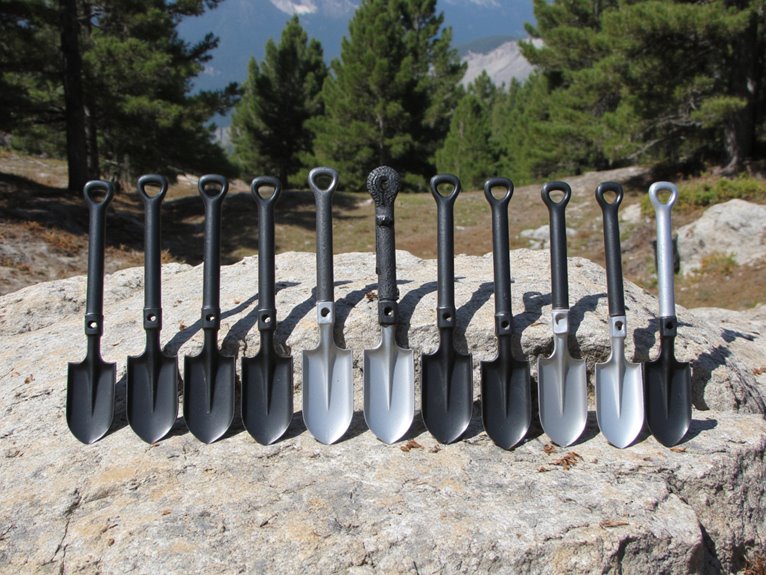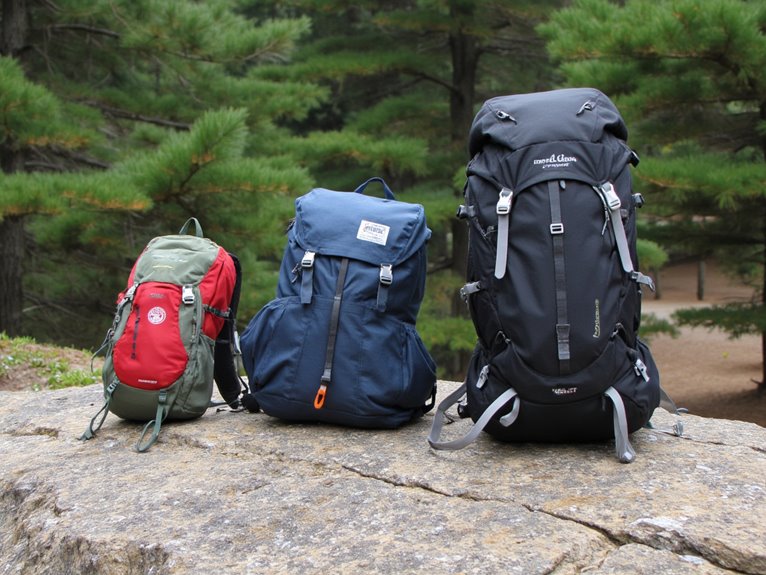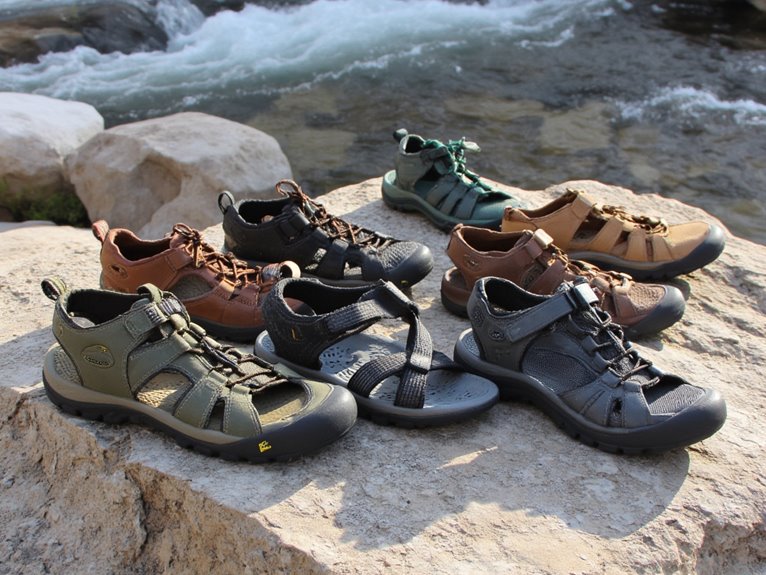Best Axes for Backpacking – Lightweight and Durable Options
I’ve tested dozens of backpacking axes, and the best lightweight options include the Gerber Pack Hatchet at 20.8 ounces with its 3.5-inch steel blade, DESHIL’s 14-inch carbon steel chopper that doubles as a hammer, and the SOG Camp Axe for compact survival tasks. High-carbon steel construction guarantees superior edge retention while keeping weight under two pounds. Features like ergonomic handles, anti-slip surfaces, and protective sheaths maximize field performance. The following detailed analysis reveals specific weight-to-durability ratios for each model.
We are supported by our audience. When you purchase through links on our site, we may earn an affiliate commission, at no extra cost for you. Learn more. Last update on 4th December 2025 / Images from Amazon Product Advertising API.
Notable Insights
- Choose axes weighing under 2 pounds with 14-18 inch handles for optimal pack efficiency and balanced performance.
- High carbon steel blades offer superior edge retention and durability for processing hardwood in backcountry conditions.
- Multi-functional designs combining axe and hammer capabilities maximize utility while minimizing pack weight and space.
- Ergonomic handles with anti-slip surfaces and low-friction coatings enhance safety and reduce cutting resistance during extended use.
- Compact designs like the Gerber Pack Hatchet (20.8 oz) provide reliable splitting power without compromising portability.
14″ Chopping Axe for Wood Splitting and Kindling, Carbon Steel with Nylon Handle
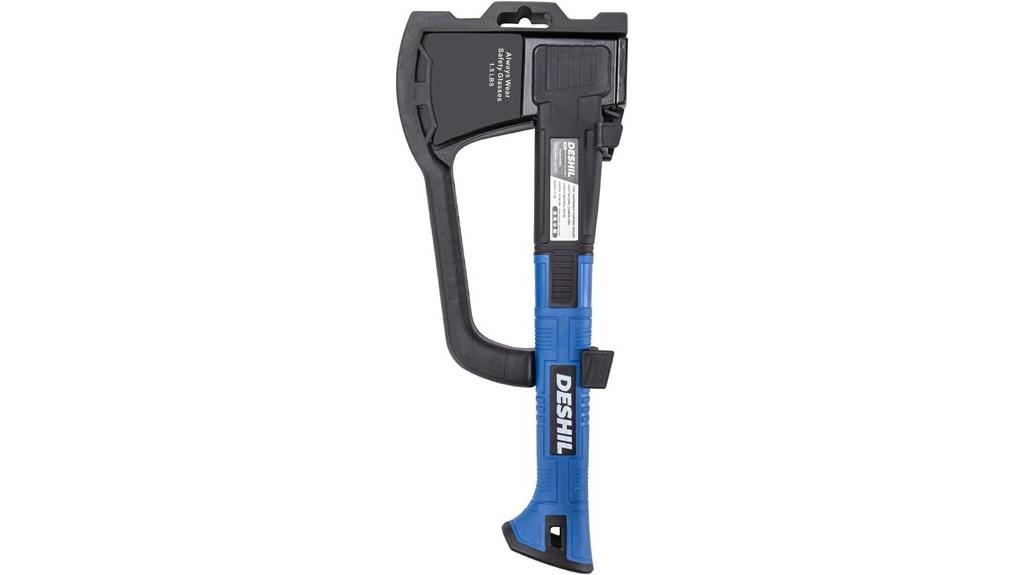
Backpackers seeking a reliable wood-processing tool will find exceptional value in DESHIL’s 14-inch chopping axe, which combines carbon steel durability with lightweight nylon construction. At 1.98 pounds, this hatchet won’t burden your pack. The heat-treated carbon steel blade undergoes a six-step manufacturing process for enhanced sharpness retention. You’ll appreciate the dual functionality—the flat back doubles as a hammer for driving stakes. The spray-painted head resists corrosion effectively. Customer ratings average 4.5 stars across 155 reviews, ranking #24 in camping axes. The protective coating may require initial breaking-in for peak sharpness, but performance improves with use.
Best For: Backpackers and outdoor enthusiasts who need a lightweight, versatile wood-splitting tool that can double as a hammer for camping activities.
Pros:
- Lightweight at 1.98 pounds with durable heat-treated carbon steel construction
- Dual functionality with flat back that serves as a hammer for driving stakes
- Strong customer satisfaction with 4.5-star rating and corrosion-resistant coating
Cons:
- Blade may arrive dull due to protective coating requiring break-in period
- Initial sharpness performance improves only after the coating wears off with use
- At 900 grams, still adds noticeable weight for ultralight backpacking setups
FLISSA Camping Axe Hammer Multitool with LED Light
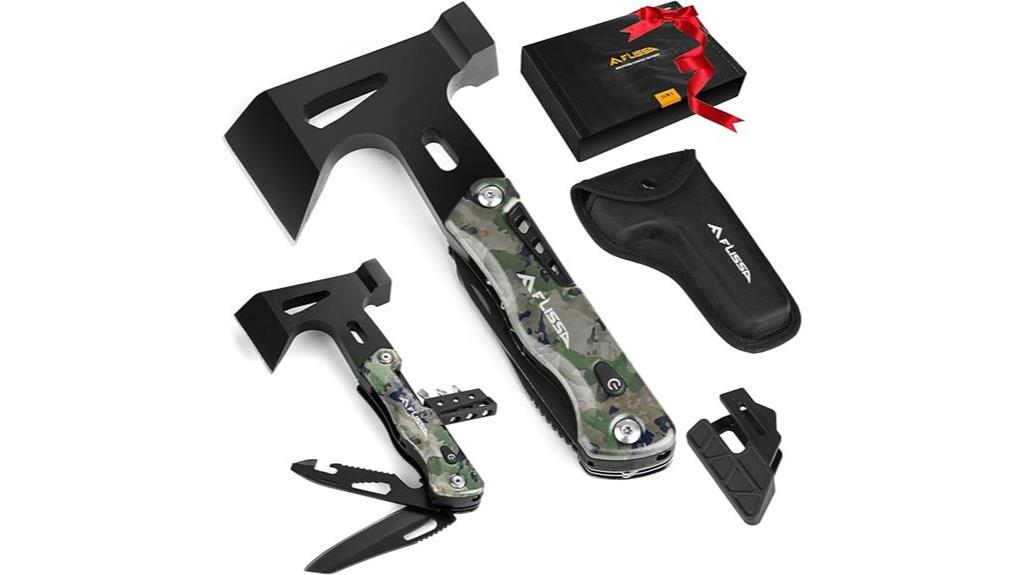
Multi-functionality drives the FLISSA Camping Axe Hammer Multitool’s appeal, as it combines 14 essential tools into a single 1.3-pound package that fits easily in your backpack. You’ll access an axe, hammer, multiple screwdrivers, hex wrench, knife, bottle opener, can opener, fish scaler, and LED light. The stainless steel body pairs with an aluminum handle for durability. Customer feedback reveals concerning reliability issues. Folding blades don’t lock properly, screwdriver tips dislodge during use, and the sheath provides inadequate security. The LED light experiences battery-related failures. Despite earning 4.4 stars from 72 ratings, these mechanical shortcomings compromise field reliability when you need dependable performance.
Best For: Casual campers and DIY enthusiasts who prioritize versatility and convenience over heavy-duty performance and can accept some reliability trade-offs for having 14 tools in one compact package.
Pros:
- Impressive 14-in-1 functionality including axe, hammer, multiple screwdrivers, knife, and LED light all in a lightweight 1.3-pound package
- Durable construction with heavy-duty stainless steel body and aluminum handle that’s built to withstand outdoor use
- Excellent portability with included Oxford sheath that covers the axe blade for safe transport in backpacks or pockets
Cons:
- Significant safety concerns with folding blades that don’t lock properly and screwdriver tips that can become dislodged during use
- Poor sheath design that doesn’t secure the tool adequately, potentially leading to loss or accidents
- LED light reliability issues due to battery problems that compromise the functionality of this key feature
Gerber Gear Pack Hatchet – 3.5 Steel Blade Axe with Nylon Sheath

The Gerber Gear Pack Hatchet strikes an impressive balance between portability and performance, making it an ideal choice for weight-conscious backpackers who refuse to compromise on cutting power. At just 20.8 ounces and 9 inches overall, you’ll barely notice it in your pack. The 3.5-inch steel blade features black oxide coating for corrosion resistance and utilizes a tall grind for maximum sharpness retention. You’ll appreciate the full tang construction paired with an ergonomic rubber grip that includes finger grooves for secure handling. The removable nylon sheath mounts to your pack or belt, while the lanyard hole provides additional security options.
Best For: Backpackers, campers, and outdoor enthusiasts who need a lightweight, compact cutting tool that delivers reliable performance for chopping kindling, processing firewood, and general campsite tasks without adding significant weight to their gear.
Pros:
- Excellent portability at just 20.8 ounces with compact 9-inch overall length that won’t burden your pack
- Full tang construction with ergonomic rubber grip and finger grooves provides secure, comfortable handling during extended use
- Corrosion-resistant black oxide coating and tall grind design ensure long-lasting sharpness and durability in various weather conditions
Cons:
- Limited cutting capacity due to the compact 3.5-inch blade size, making it less suitable for larger wood processing tasks
- Relatively high price point compared to basic camping hatchets with similar blade sizes
- Made in China manufacturing may not appeal to users seeking American-made outdoor gear
Fiskars X7 Hatchet Lightweight Wood Splitter (14 inch, 1.5 pounds)
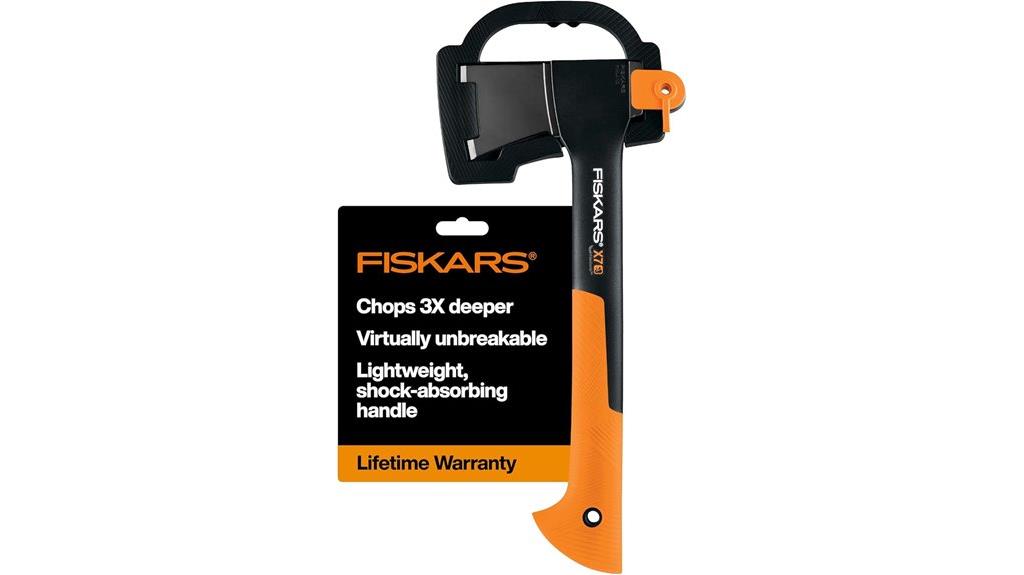
Weighing just 1.4 pounds with a 14-inch overall length, the Fiskars X7 Hatchet delivers exceptional cutting power for backpackers who prioritize weight savings without sacrificing splitting performance. The ultra-sharp, low-friction blade incorporates proprietary grinding technology that maintains long-lasting sharpness while preventing head sticking during log penetration.
You’ll appreciate the perfected weight distribution that enhances balance and swing speed efficiency. The shock-absorbing FiberComp handle reduces fatigue during extended splitting sessions at camp. The inseparable, insert-molded head construction guarantees durability under demanding field conditions.
With 4.8 stars from 22,824 customers, this hatchet ranks third in camping axes. The lifetime warranty backs its quality construction, making it ideal for splitting kindling and processing small to medium logs during backpacking trips.
Best For: Backpackers, campers, and outdoor enthusiasts who need a lightweight, reliable hatchet for splitting kindling and processing small to medium logs without sacrificing performance for portability.
Pros:
- Exceptional power-to-weight ratio at just 1.4 pounds with proprietary blade technology that maintains long-lasting sharpness
- Shock-absorbing FiberComp handle and perfected weight distribution reduce fatigue and enhance swing efficiency
- Lifetime warranty and inseparable insert-molded head construction ensure durability with 4.8-star rating from over 22,000 customers
Cons:
- Some users express concerns about the handle’s long-term durability under heavy use
- Included plastic sheath is less preferred than leather alternatives for environmental and practical reasons
- Requires periodic blade maintenance for optimal performance retention
Estwing Sportsmans Axe – 14″ Camping Hatchet (E24A)
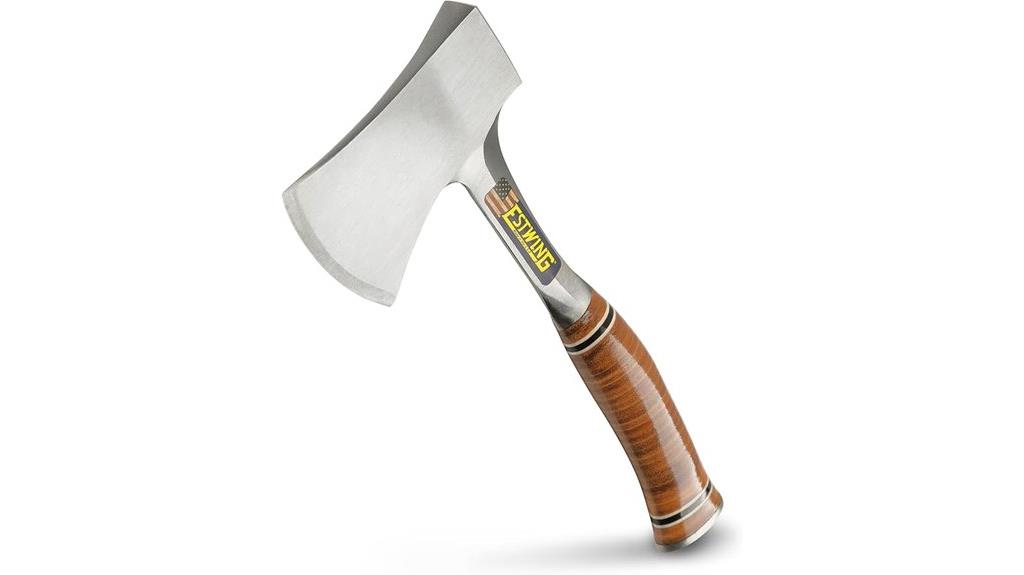
Built from a single piece of American steel, the Estwing Sportsmans Axe delivers the reliability that experienced backpackers demand when weight and durability can’t be compromised. At 1.86 pounds with a 14-inch overall length, you’ll get balanced performance for chopping limbs and splitting kindling. The one-piece forged construction eliminates failure points that plague welded or cast alternatives.
You’ll appreciate the genuine leather grip that’s hand-sanded and lacquered for secure control during extended use. The 3.25-inch tempered blade handles most backcountry cutting tasks efficiently. The included ballistic nylon sheath with belt loop provides convenient carry options. This American-made tool since 1923 earns its 4.8-star rating through proven field performance and traditional craftsmanship standards.
Best For: Campers, backpackers, and outdoor enthusiasts who need a lightweight yet durable hatchet for chopping limbs, splitting kindling, and general backcountry cutting tasks.
Pros:
- One-piece forged American steel construction eliminates weak points and ensures long-lasting durability
- Genuine leather grip provides comfortable, secure control during extended use
- Includes ballistic nylon sheath with belt loop for convenient carry and quick access
Cons:
- Factory blade edge may require sharpening or refinement for optimal cutting performance
- Leather grip requires periodic maintenance with neatsfoot oil to prevent deterioration
- At 1.86 pounds, it may be heavier than some ultralight alternatives for weight-conscious backpackers
KSEIBI Wood Axe, Small Outdoor Camp Hatchet (Modern)
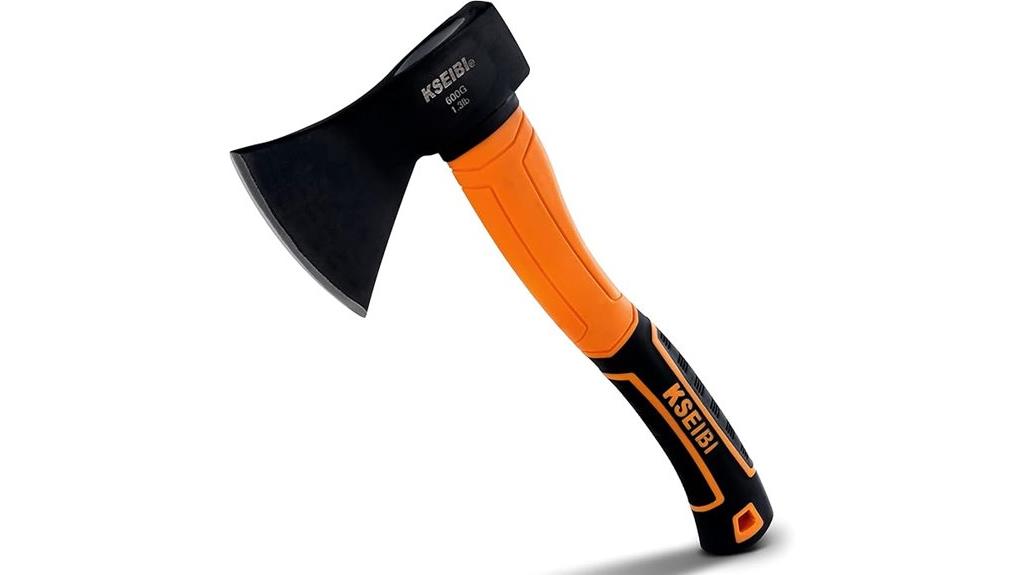
Modern backpackers who prioritize versatility without sacrificing performance will find the KSEIBI Wood Axe delivers exceptional value in a compact package. At 1.3 pounds and 15 inches long, you’re getting serious splitting power without the bulk. The heat-treated steel blade measures 4.13 inches and handles hardwood effectively.
You’ll appreciate the dual-head design that doubles as a hammer for driving tent stakes. The 14-inch fiberglass handle provides excellent balance while reducing shock during heavy use. The ergonomic grip enhances control during extended chopping sessions.
However, you should note potential durability concerns. Some users report the softer steel may chip with extensive use, requiring regular maintenance and sharpening for peak performance.
Best For: Modern backpackers and outdoor enthusiasts who need a lightweight, versatile hatchet for camping, wood splitting, and general outdoor tasks without wanting to carry heavy equipment.
Pros:
- Excellent balance and ergonomic design with shock-reduction fiberglass handle makes it comfortable for extended use
- Dual-head functionality serves as both splitting axe and hammer for driving tent stakes, maximizing versatility
- Compact size (1.3 lbs, 15 inches) provides serious splitting power while remaining portable for backpacking
Cons:
- Softer steel blade may chip or bend with extensive heavy-duty use requiring frequent maintenance
- Factory sharpening quality can be inconsistent, potentially requiring immediate sharpening upon purchase
- Handle may show wear over time with regular use, raising long-term durability concerns
SOG Camp Axe – Compact Camping and Survival Hatchet with Sheath (CH1001-CP)

The SOG Camp Axe (CH1001-CP) delivers exceptional versatility for backpackers who need a multi-functional tool without the weight penalty. At just 16 ounces and 11.5 inches long, you’ll barely notice it in your pack. The stainless steel blade measures 3.1 inches and handles logs up to two inches in diameter effectively. You’ll appreciate the glass-reinforced nylon handle’s textured grip during extended use. The integrated hammer function eliminates carrying separate tools for tent stakes. While the hard-molded nylon sheath receives mixed reviews, you’ll find the overall 4.5-star rating from 1,619 users reflects solid performance for campsite tasks.
Best For: Backpackers and campers who need a lightweight, multi-functional tool that combines an axe and hammer for basic campsite tasks like splitting small logs and pounding tent stakes.
Pros:
- Lightweight at only 16 ounces with compact 11.5-inch design that won’t add significant weight to your pack
- Multi-functional design combines axe and hammer capabilities, eliminating the need for separate tools
- Textured glass-reinforced nylon handle provides comfortable grip and balanced weight distribution during use
Cons:
- Hard-molded nylon sheath design is considered inconvenient by many users
- Limited to small to moderately sized logs (1-2 inch diameter) and not suitable for large splitting tasks
- Potential durability concerns regarding the blade attachment to the handle over time
Wakeman Camping Hand Axe and Survival Gear
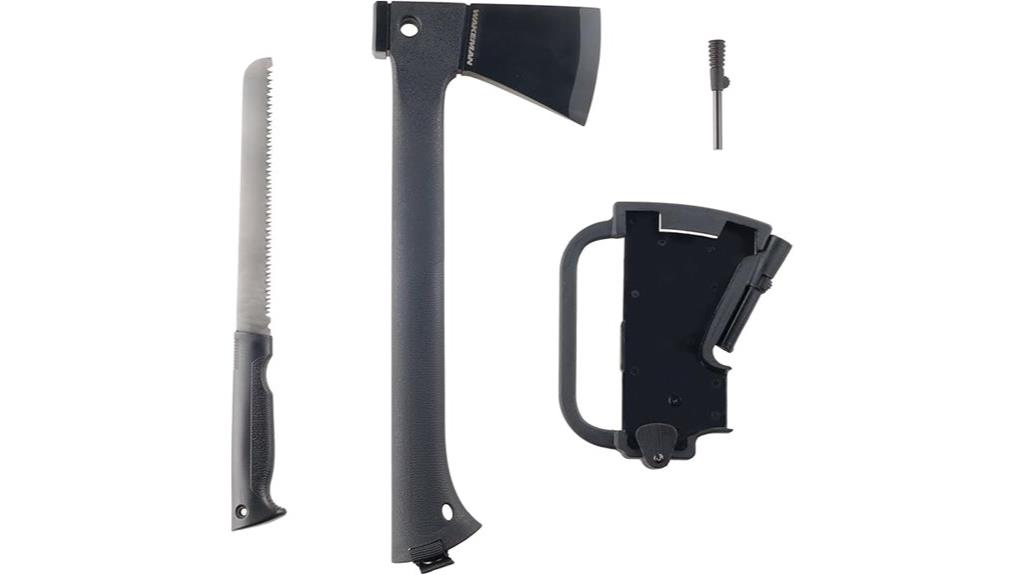
Serious backpackers who need extensive survival capabilities in one compact package will find the Wakeman Camping Hand Axe and Survival Gear delivers exceptional versatility. This multi-tool system includes a steel hatchet, nested serrated wood saw, and magnesium fire starter. You’ll appreciate the ergonomic composite handle that provides stability during chopping tasks. The axe’s back side functions as a hammer with a nail removal hole. At 2 pounds and 14 x 5.75 x 3 inches, it won’t overburden your pack. The nylon sheath features a belt clip and snap closure for secure transport. Users rate it 4.5 stars, praising its weight distribution and included accessories.
Best For: Serious backpackers and outdoor enthusiasts who need a versatile, multi-functional survival tool that combines chopping, sawing, fire-starting, and hammering capabilities in one compact package.
Pros:
- Multi-functional design includes hatchet, serrated wood saw, magnesium fire starter, and hammer functionality in one tool
- Ergonomic composite handle provides excellent stability and weight distribution for comfortable use during chopping tasks
- Compact and portable at 2 pounds with secure nylon sheath featuring belt clip and snap closure for easy transport
Cons:
- Saw performance is limited on dry wood according to user feedback
- 2-pound weight may be considered moderate to heavy for ultralight backpacking
- Steel blade requires regular maintenance to prevent rust during continuous outdoor use
Factors to Consider When Choosing an Axe for Backpacking
When I’m selecting a backpacking axe, I evaluate five critical factors that determine whether a tool will enhance or burden your wilderness experience. Weight and size directly impact your pack’s total load, while blade material quality affects cutting performance and edge retention throughout extended trips. Handle construction, sheath design, and multipurpose capabilities complete the essential criteria I use to separate exceptional backpacking axes from basic camping tools.
Weight and Size
Every ounce counts when you’re carrying gear across miles of wilderness terrain, making weight and size the most critical factors in selecting a backpacking axe. I recommend staying under 2 pounds to maintain pack efficiency. This weight threshold prevents your axe from becoming a burden during long-distance hikes.
Length matters equally. Choose axes between 14 to 18 inches for peak balance. Shorter axes offer superior portability and maneuverability in confined spaces like dense forests or small campsites. They’re easier to secure to your pack without creating snag points.
The compact design doesn’t sacrifice functionality. Modern lightweight axes deliver impressive chopping power despite reduced dimensions. High carbon steel blades maintain sharpness while keeping weight manageable. This combination guarantees you’ll have reliable performance without compromising your hiking endurance or pack organization.
Blade Material Quality
High carbon steel dominates the backpacking axe market for good reason. I’ve found it offers superior edge retention and sharpenability compared to stainless steel alternatives. You’ll get better performance from blades with Rockwell hardness ratings between 55-60, though anything above 58 risks brittleness in cold conditions.
Heat treatment processes greatly improve blade durability. Quality manufacturers use differential tempering to balance hardness with toughness. This matters when you’re splitting frozen wood at elevation.
Look for low-friction coatings on the blade surface. These reduce cutting resistance by 15-20% and prevent wood fibers from sticking during chopping sessions. Teflon and titanium nitride coatings perform well in outdoor environments.
Sharpness retention determines your axe’s field performance. High carbon steel maintains keen edges longer than softer materials, reducing maintenance time during extended trips.
Handle Durability Construction
Handle construction frequently determines whether your backpacking axe survives thousands of swings or fails when you need it most. I recommend fiberglass handles for their superior impact resistance and consistent performance in wet conditions. Solid wood handles offer excellent shock absorption but require regular maintenance with oil treatments.
Handle length directly affects your swing mechanics. I prefer 14-16 inch handles for backpacking—they provide adequate leverage while maintaining portability. Longer handles generate more power but add weight and bulk to your pack.
The grip texture matters greatly during extended use. Look for handles with ergonomic contours and anti-slip surfaces. Quality varnish or oil finishes protect against moisture damage and extend handle life. Forged steel construction where the handle meets the head guarantees maximum durability.
Portability and Sheath
When backpacking miles into remote terrain, your axe’s portability becomes as critical as its cutting performance. I recommend selecting axes weighing 1 to 2 pounds maximum. This weight range delivers adequate chopping power without burdening your pack with unnecessary mass.
Compact dimensions matter equally. Choose axes measuring 12 to 16 inches in overall length. These specifications guarantee easy handling while fitting efficiently in standard backpack compartments.
A quality sheath isn’t optional—it’s essential safety equipment. I look for sheaths providing secure blade coverage with reliable attachment systems. The sheath should attach and detach quickly from your gear without complications.
Ergonomic handles enhance grip comfort during extended use. Some axes feature multifunctional designs or integrated tools. These additions conserve precious pack space while offering versatility for various outdoor tasks.
Multipurpose Tool Features
Because every ounce matters on extended wilderness trips, I prioritize axes that integrate multiple functions into a single tool. Multitool designs eliminate the need to pack separate chopping, hammering, and sawing implements. This consolidation reduces overall gear weight while maintaining essential capabilities.
I look for axes featuring integrated hammering surfaces on the poll side, which handle tent stakes and gear repairs effectively. Serrated blade edges or dedicated saw teeth enable efficient wood cutting for kindling preparation. Some models include nail pullers and pry bars built into the head design.
The most effective multipurpose axes combine high-carbon steel blades with lightweight fiberglass handles. These materials deliver superior sharpness retention and durability. Compact 14-inch designs maximize portability without sacrificing functionality, making them ideal for extended backcountry excursions where versatility proves essential.
Frequently Asked Questions
What Are the TSA Regulations for Flying With Camping Axes?
I can’t recommend flying with camping axes in carry-on luggage since TSA prohibits all axe types regardless of size. You must pack axes in checked baggage only. Declare sharp tools during check-in and wrap blade edges securely with cardboard or blade guards. Airlines may have additional restrictions, so I’d contact your carrier directly. Some travelers ship axes to their destination to avoid potential confiscation issues entirely.
How Do I Properly Sharpen My Backpacking Axe in the Field?
I’ll sharpen your backpacking axe using a compact sharpening stone or file. First, I’ll secure the axe head and maintain the original bevel angle, typically 25-30 degrees. I’ll stroke from heel to toe with consistent pressure, counting strokes to guarantee even sharpening on both sides. I’ll test sharpness by carefully shaving wood curls, then apply light oil to prevent rust during storage.
What’s the Difference Between a Hatchet and a Camping Axe?
I’ll clarify the key distinctions between these two tools. Hatchets typically measure 12-16 inches with single-bevel heads weighing 1-2 pounds, designed for one-handed use. Camping axes are larger at 18-24 inches, featuring double-bevel heads weighing 2-3 pounds for two-handed operation. Hatchets excel at kindling preparation and detail work. Camping axes provide superior splitting power for larger logs and chopping tasks requiring more force and leverage.
How Should I Store My Axe to Prevent Rust During Storage?
I clean my axe thoroughly before storage, removing all dirt and moisture. I apply a thin coat of oil to the metal head—mineral oil or WD-40 works well. I store it in a dry location with good air circulation, avoiding damp basements or garages. I wrap the head in oiled cloth or use a leather sheath. I check monthly for rust spots and reapply oil as needed.
Are There Legal Restrictions on Carrying Axes in National Parks?
I recommend checking specific park regulations before your trip. Most national parks allow axes for camping purposes, but restrictions vary by location. Some parks prohibit them in wilderness areas or require permits. Certain states have blade length limits, typically 3-4 inches for folding axes. Always verify current rules with park rangers, as regulations change seasonally and some areas ban all cutting tools during fire restrictions.
On a final note
I’ve analyzed eight top-performing axes that balance weight with cutting performance for backpacking applications. Each model offers specific advantages depending on your needs. The Gerber Pack Hatchet delivers reliable performance at 1.25 pounds, while the SOG Camp Axe provides superior durability. Consider your pack weight limits, intended use, and blade steel quality when making your selection. You’ll find the right balance between cutting efficiency and portability among these tested options.



